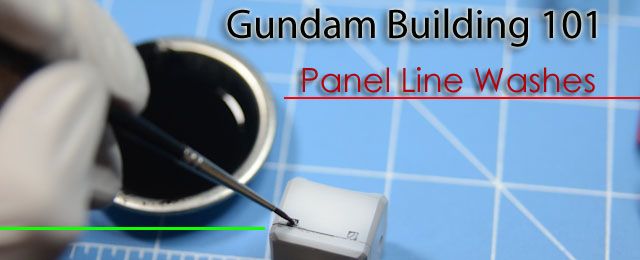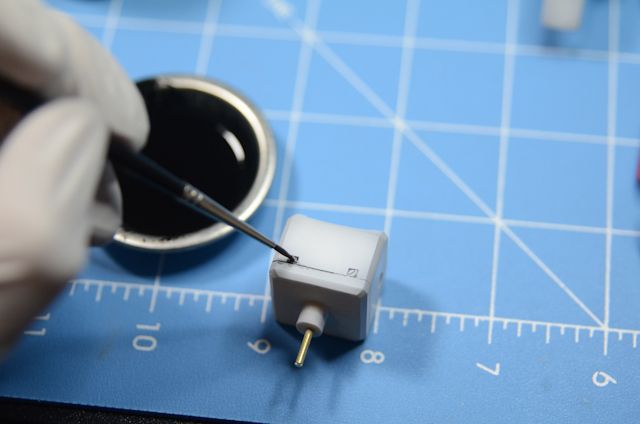
Ah yes, the mysterious panel line wash.
I've seen some tutorials on it, everyone says it's easy, and yet, I see it so little. If more people knew how easy it was, maybe we would see it more often. I see many people using the Gundam Markers, sharpies, and pencils where using a panel wash is actually easier and requires less investment.I am creating this tutorial to shed some light on this.
Panel lining is simply adding dark lines to crevasses and lines that occur along pieces in your model. This adds depth that sometimes is missing using small scale models that would otherwise occur on a larger version. You can also think of this as 'outlining' or 'inking' your model to give it a much more defined look.
Materials Needed for this Process:
- Model pieces that may or may have not been painted- Glossy Top Coat (Future or any other non-enamel gloss coat)
- A turpenoid based lighter fluid (I recommend Zippo lighter fluid - costs $1.99 for ~3-4oz., there is also a yellow bottle called Ronsonol) - I bought it at a cigarette store, or the cigarette section at a grocery store.
- Q-tips
- Black (or gray) enamel paint
Standard Modeling Tools:
- Mixing tin- Small-tipped paint brush
1. Coat your part with Future or other gloss coat. I use Plamo Colour Gloss coat (lacquer based). If you are painting, make sure you are done painting your part for this. I recommend having the decals on already too. Let the parts dry. Note: Make sure your gloss coat is either Acrylic or Lacquer, and NOT enamel. This will not work if you use an enamel coat.

2. Mix enamel black paint and lighter fluid in a 60:40 ratio. Make sure it is well mixed.

3. With a fine tipped brush, dab the paint into the crevasses and (if you want) where edges and corners meet. Make sure the paint brush has lots of paint liquid in it, and you only want to DAB it in the crevass so that it will flow out of the tip and into the crevass, like water into a water slide.

4. Let the part dry for about 5-10 minutes. It should look something like the above.


4. Let the paint dry for about 10 minutes (move onto other pieces), then get your q-tip damp with some Zippo lighter fluid and clean up the paint drops that are on the surface. Note: Here is where technique and practice will come in handy. Make sure the tip isn't covered with liquid, only slightly damp, and evenly and delicately glide the q-tip across the surface.

5. Enjoy your hard work. Easy, wasn't it?
6. Add a flat top coat to make it look super slick!
Here are some other before and after pics:




Also note: the lighter fluid dries quickly, even in the tray you mix with paint. Make sure the solution is relatively thin (not thick like paint) before you put it on your part by adding more lighter fluid if necessary.



thanks for the tips. Also I have heard laquer is bad for plastic, is this true?
ReplyDeleteYes lacquer is bad for plastic. It can also melt the plastic down. :)
DeleteDepends on how u use it. Most of d greatvwork u see in d net are done in lacquer paint n lacquer thinner.
DeleteSame thing as enamel thinner.
Bandai plastic is extremely weak towards enamel thinner. That u gotta be careful.
I've heard of some people doing a similar process with oil paints. Have you tried oils in panel lines? Is this way easier?
ReplyDeleteI have not tried oils, though it may be difficult as I've found there is no reliable way to clean up the excess, and it takes forever to dry. This takes ~10-15 minutes in a 75 degree room.
DeleteI thought enamel paints are oil based paint? I'm using enamel paint with paint thinner.. They are perfectly fine...
Deletehi i would like to as if i am hand painting with enamel paint, is it advisable to still use lighter fluid as the thinning agent?
ReplyDeleteIf you are painting with enamel, I would recommend a lacquer or acrylic top coat to go on top of the paint before you do the wash. Then you can use the enamel paints. Otherwise the lighter fluid will strip all enamel paint it comes in contact with.
DeleteCan i use isopropyl alcohol to replace the zippo fluid to thinning the enamal?
DeleteWhy is it that you want to use the top coat first? Would this method still work if you used the top coat after the panel line wash? I just feel like you'd want to seal in the panel line wash so it wouldn't dull over time. Thank you Major Williams, great guide and I will definitely try this out.
ReplyDeleteIf you are doing an enamel wash like above, a top coat is not necessary if you have painted the piece in either acrylic or Lacquer. It is necessary if you have painted in enamel, though, because the acrylic top coat will not be affected by the lighter fluid. I hope that description is clear enough for you!
DeleteHey there, your blog is awesome and has helped me immensely with some of my projects.
ReplyDeleteI realise that this is coming a little bit *late*, but I want to try your panel lining technique, but it is pretty hard for me to find lighter fluid where I am staying.
I do, however, have enamel thinners. Will this act as a sufficient substitute for the lighter fluid, or should I go out of my way to locate some zippo fluid anyway?
Thanks
What do you think of the Tamiya pre-mixed panel line wash?
ReplyDeleteThe smearing this method leaves is it's weakness, oil paint is preferable.
ReplyDeleteYou can also use this technique to create rust streaks by using a rust colored enamel paint, and instead of a q-tip use a brush dampened with lighterfluid and blend it out in a downward motion.
ReplyDeletecouldnt I use gouache and thin it with isopropyl alcohol? then clean up with water?
ReplyDeleteWhy do some people say to decal after panel washing?
ReplyDeleteCan this be applied to panel markers also?
ReplyDeleteIs the Glossy Top Coat necessary?? and would using an enamel thinner work in replacement of the lighter fluid??
ReplyDeleteWhat if i used enamel thinner instead of lighter fluid? Would that still work?
ReplyDeletelacquer is really bad for plastic, if i use mr.surfacer 1000 (lacquer, right?) as primer, and then paint another lacquer based color layer on top of it. Is there any effects? please help, admin
ReplyDeleteCan I use Acrylic for wash and use a enamel gloss coat?
ReplyDeletebenefit of using panel wash for tshirts
ReplyDelete